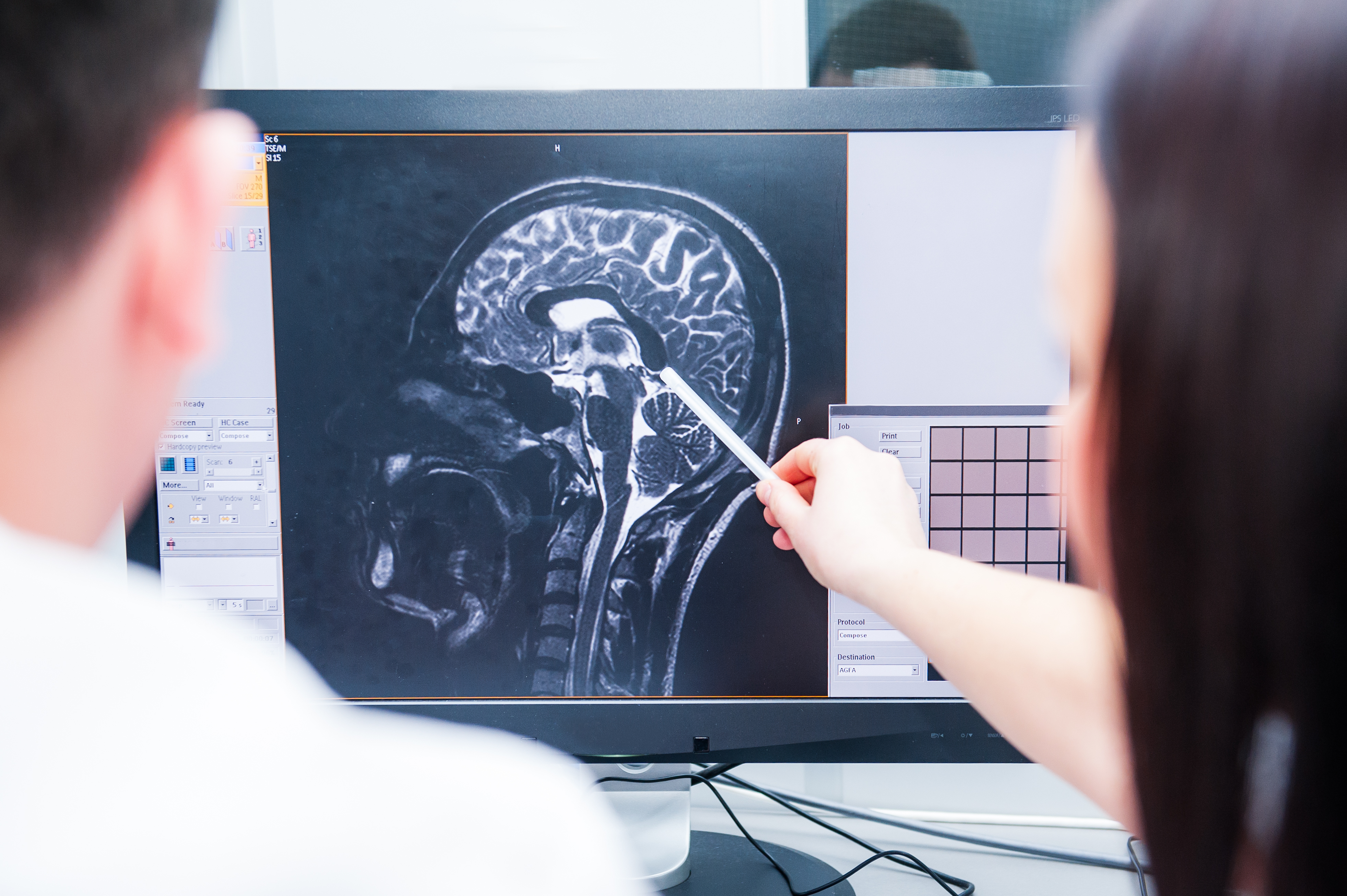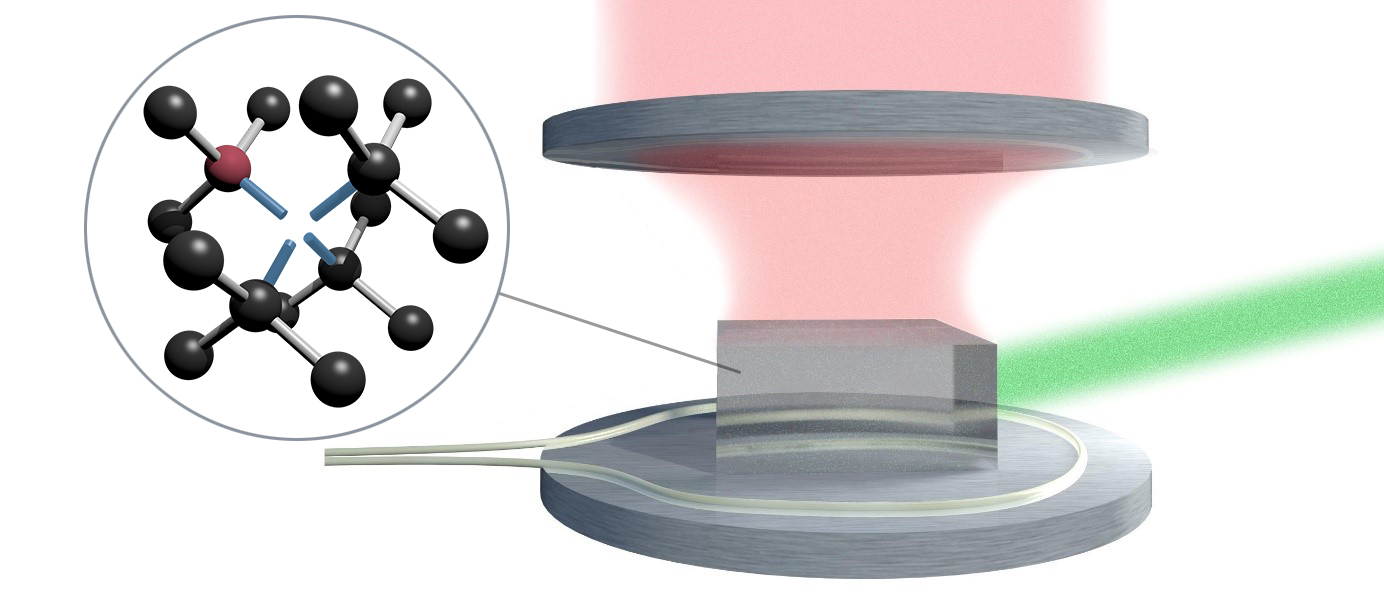Quantum sensors – Fraunhofer IAF launches a project for medical applications
Measuring Smallest Magnetic Fields in the Brain Using Diamond and Laser Technology
In July 2018, a research project with an entirely innovative approach to measuring magnetic fields in tissue started at the Fraunhofer Institute for Applied Solid State Physics IAF: The scientists in Freiburg will produce and optimize NV centers in diamond in order to achieve highly sensitive magnet field detectors working at room temperature, and by those means develop the world’s first laser threshold magnetometer. Smallest magnetic fields, like the ones produced in neuronal networks or through brainwaves, can be detected with this technology, which will advance medical diagnostics. The research project with the working title »NV-doped CVD diamond for ultra-sensitive Laser Threshold Magnetometry«, short »DiLaMag«, is supported by the German Federal Ministry of Education and Research (BMBF).
The measurement of magnetic fields has become a standard practice in medical diagnostics. Smallest electrical currents flow inside the nerve cells of brains and hearts and produce weak magnetic fields. Precise magnetic field sensors are able to measure the activity of brains (MEG) or hearts (MKG) and allow for imaging procedures such as magnetic resonance tomography (MRT) in order to detect diseases. The required precision for these measurements, however, is only achieved by a few highly sensitive magnetic field sensors usually working at extreme low-temperature cooling.
Highly Precise Magnetic Field Measurements at Room Temperature
»Most magnetometers are not precise enough to measure the weak signals of the brain. Common highly sensitive magnetic field sensors, such as SQUID sensors, function only with extreme cooling, which makes their use extremely cost-intensive and technologically complex. Innovative sensor technologies such as nitrogen vacancy centers (NV centers) or vapor cell magnetometers could become an important alternative«, explains Dr. Jan Jeske, researcher at Fraunhofer IAF and project manager of »DiLaMag«.
Innovative opportunities for highly sensitive sensor technologies arise from researching new quantum physical systems and from enhancing the materials basis of the sensors. In this regard, the research project »DiLaMag« wants to achieve ultra-sensitive laser threshold magnetometry with the help of atomic nitrogen vacancy centers. For this purpose, the scientists at Fraunhofer IAF work on the development of the world’s first highly NV-doped diamond laser crystals. Highly sensitive magnetic field sensors, suited for biological applications, would for example allow for the measurement of brain and heart activities of unborn babies, and therefore help prenatal treatment of diseases. The German Ministry for Education and research (BMBF) supports the five-year project as part of their youth competition »NanoMatFutur« – a program to promote young and highly qualified scientists in the field of materials development (FKZ: 13XP5063).
Diamond as a Laser Medium
Laser threshold magnetometry (LSM) is an entirely new research approach. What’s new about it: NV-doped diamond is used as a laser medium in order to develop highly precise laser threshold magnetometers. Jeske developed this concept during his time as a postdoctoral fellow at the RMIT University of Melbourne. »The crucial idea of LSM is based on the concept of using a material as a laser medium that has an optically detectable magnetic resonance. Diamond with a high density of NV centers is especially well suited as laser medium due to its exceptional material characteristics«, explains Jeske. The scientists expect stronger signals and higher contrasts with NV-doped diamond as laser medium, which will lead to significantly more precise measurement results. »A crucial advantage is the usability of NV centers in diamonds at room temperature, as they maintain their quantum properties – in contrast to, for example, SQUID sensors«, reasons the scientist.
-------------------------------------------------------------------------------------------------------------------------------------------------------------
Nitrogen Vacancy Centers in Diamond
Nitrogen vacancy center (NV centers) are atomic systems consisting of one nitrogen atom and a carbon vacancy inside a diamond. They absorb green light and emit red light. As the luminosity of these NV centers depends on the intensity of an exterior magnetic field and as the centers are only the size of an atom, they can be used to measure magnetic fields with both high spatial resolution and high sensitivity.
--------------------------------------------------------------------------------------------------------------------------------------------------------------
»The measuring principle is based on the competition between stimulated and spontaneous emission, which can be influenced by smallest magnetic fields«, describes Jeske. The proof that the concept of LSM functions not only theoretically has been provided by first experiments: »The experiments have clearly shown that NV diamond shows stimulated emission and is therefore principally suited as laser material. The next step is to improve the optical properties of diamond and to build the actual measuring system«, says Jeske, who recently returned to the German research scene after his seven-year long stay in Australia.
Setup of a NV Diamond Laser Laboratory
By fusing three core competences of Fraunhofer IAF, namely diamond growth, laser technology and high frequency electronics, quantum magnetometry can quickly be transferred from basics to applied systems. The »DiLaMag« research team now stands at the initial phase of its work: The first step is growing diamonds via a plasma-based CVD procedure and treating them in a way as to minimize losses through absorption, scattering and double scattering. The challenge in this process is to enrich diamond with as many NV centers as possible without lowering the material quality. Subsequently, the project team plans on producing diamond layers with the optimal NV density inside the plasma CVD reactors of Fraunhofer IAF, and to characterize relevant physical and optical parameters of the material. The required infrastructure is currently being established at Fraunhofer IAF.
Project Aims and Cooperation
The aim of the first project stage is to improve the material characteristics of highly NV-doped diamond, as well as its analysis, in order to produce optimized laser crystals and to develop first demonstrators of the LSM. The second project stage focusses on the further improvement of the sensitivity and the measuring of magnetic field signals of biological cells. The project also draws on close cooperation with SIGMA Medizin-Technik GmbH (medical technology Ltd.), who will provide the technical equipment for first biological comparison measurement. The project receives support from the medical side as well, as experts in the field of biomagnetism from the university hospital of Freiburg and Heidelberg will accompany the first measurements.
The use of this photographs is only permitted in relation to this press release.
Last modified:
 Fraunhofer Institute for Applied Solid State Physics IAF
Fraunhofer Institute for Applied Solid State Physics IAF

